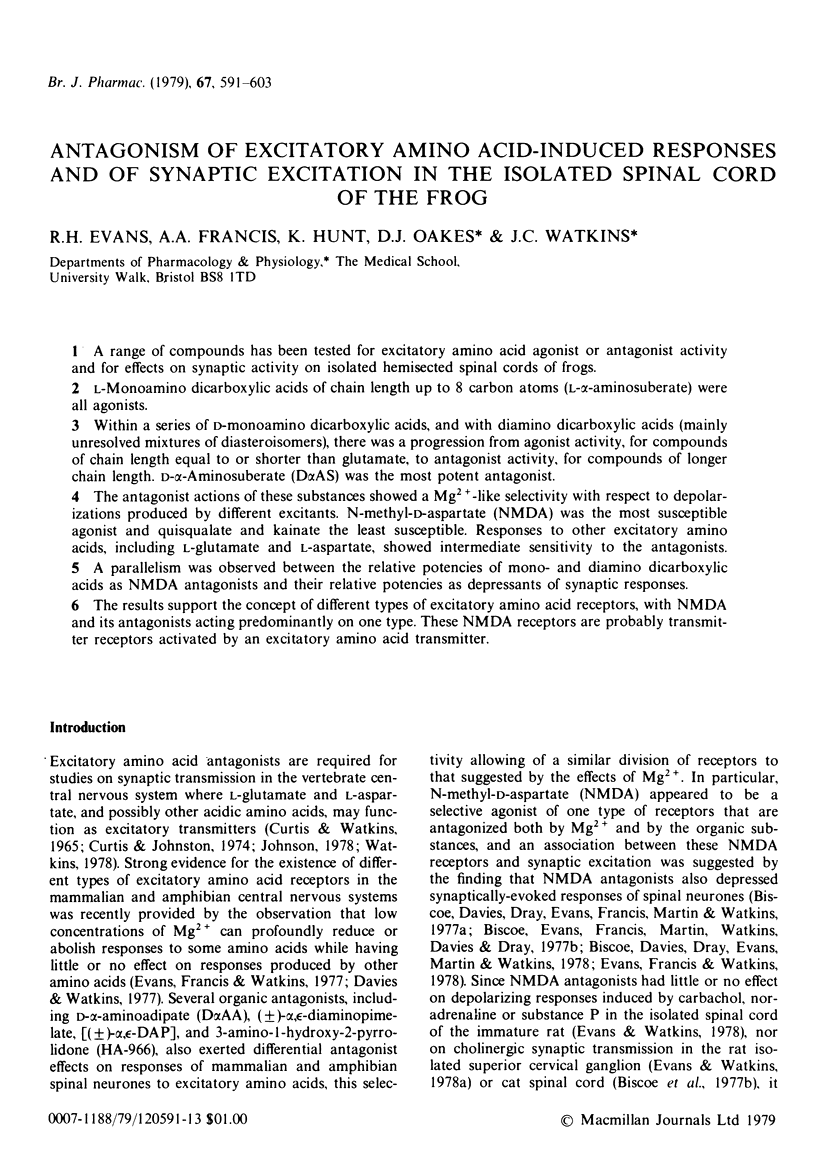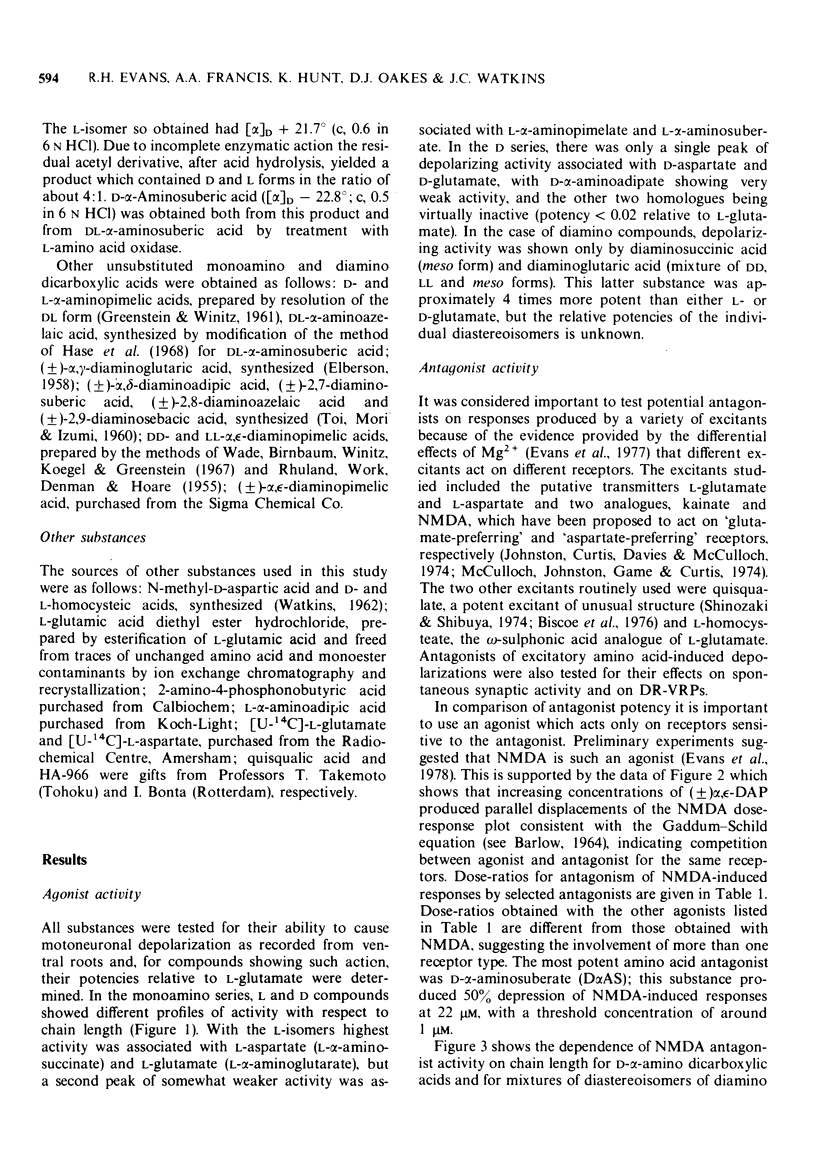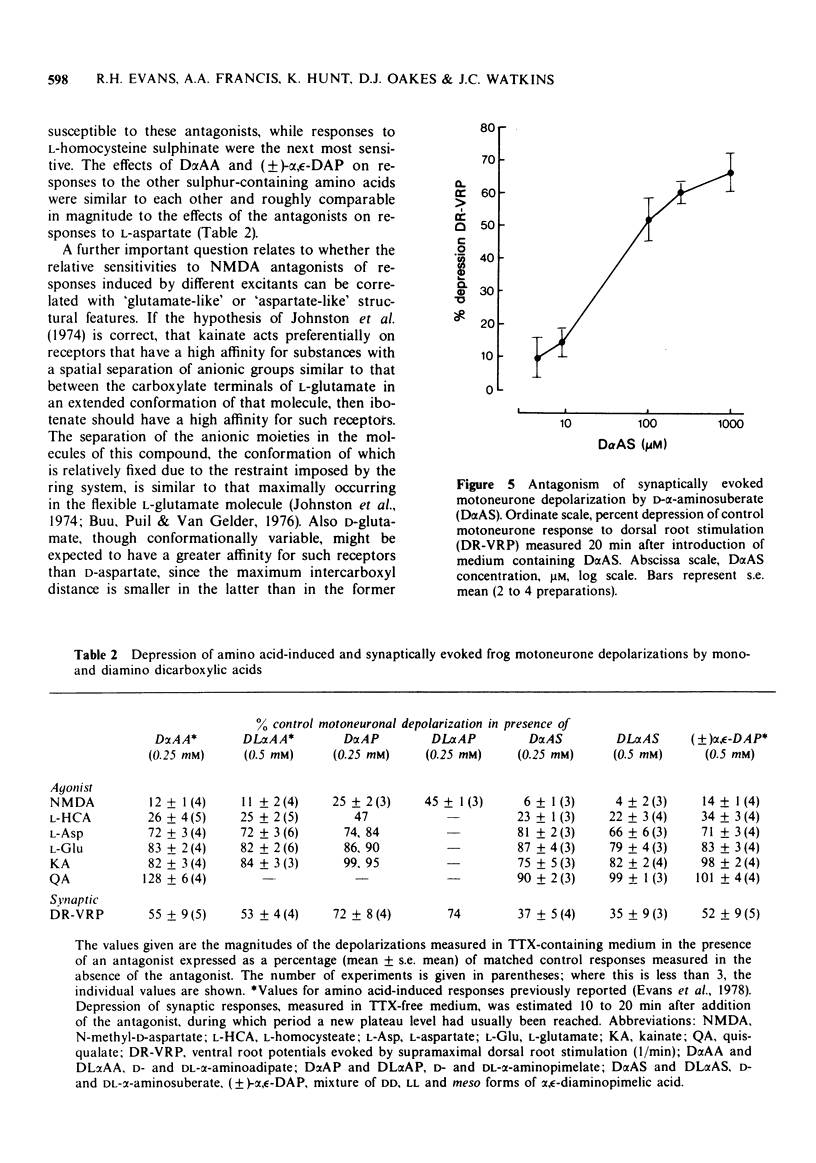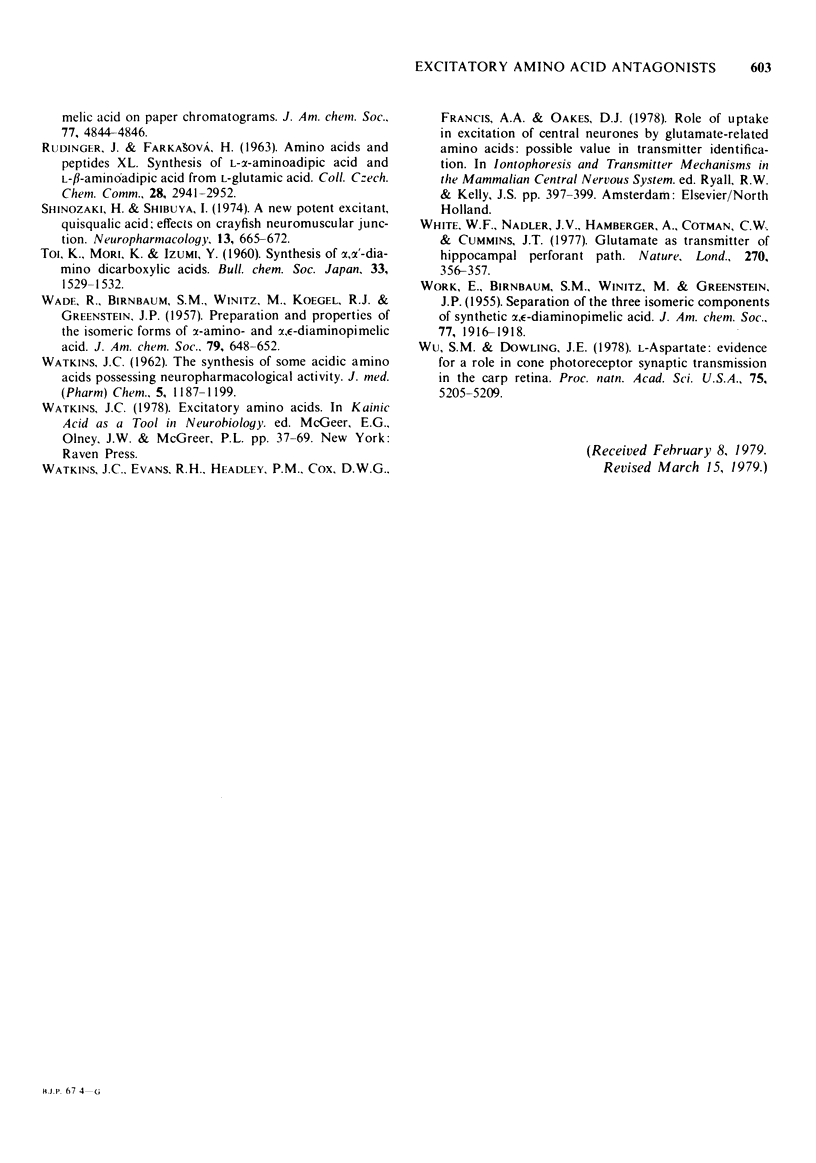Abstract
1. A range of compounds has been tested for excitatory amino acid agonist or antagonist activity and for effects on synaptic activity on isolated hemisected spinal cords of frogs. 2. L-Monoamino dicarboxylic acids of chain length up to 8 carbon atoms (L-alpha-aminosuberate) were all agonists. 3. Within a series of D-monoamino dicarboxylic acids, and with diamino dicarboxylic acids (mainly unresolved mixtures of diasteroisomers), there was a progression from agonist activity, for compounds of chain length equal to or shorter than glutamate, to antagonist activity, for compounds of longer chain length equal to or shorter than glutamate, to antagonist activity, for compounds of longer chain length, D-alpha-Aminosuberate (D alpha SD) was the most potent antagonist. 4. The antagonist actions of these substances showed a Mg2+--like selectivity with respect to depolarizations produced by different excitants. N-methyl-D-aspartate (NMDA) was the most susceptible agonist and quisqualate and kainate the least susceptible. Responses to other excitatory amino acids, including L-glutamate and L-aspartate, showed intermediate sensitivity to the antagonists. 5. A parallelism was observed between the relative potencies of mono- and diamino dicarboxylic acids as NMDA antagonists and their relative potencies as depressants of synaptic responses. 6. The results support the concept of different types of excitatory amino acid receptors, with NMDA and its antagonists acting predominantly on one type. These NMDA receptors are probably transmitter receptors activated by an excitatory amino acid transmitter.
Full text
PDF












Selected References
These references are in PubMed. This may not be the complete list of references from this article.
- Balcar V. J., Johnston G. A. Glutamate uptake by brain slices and its relation to the depolarization of neurones by acidic amino acids. J Neurobiol. 1972;3(4):295–301. doi: 10.1002/neu.480030403. [DOI] [PubMed] [Google Scholar]
- Biscoe T. J., Davies J., Dray A., Evans R. H., Francis A. A., Martin M. R., Watkins J. C. Depression of synaptic excitation and of amino acid induced excitatory responses of spinal neurones by D-alpha-aminoadipate, alpha,epsilon-diaminopimelic acid and HA-966. Eur J Pharmacol. 1977 Oct 1;45(3):315–316. doi: 10.1016/0014-2999(77)90017-6. [DOI] [PubMed] [Google Scholar]
- Biscoe T. J., Davies J., Dray A., Evans R. H., Martin M. R., Watkins J. C. D-alpha-aminoadipate, alpha, epsilon-diominopimelic acid and HA-966 as antagonists of amino acid-induced and synpatic excitation of mammalian spinal neurones in vivo. Brain Res. 1978 Jun 16;148(2):543–548. doi: 10.1016/0006-8993(78)90745-x. [DOI] [PubMed] [Google Scholar]
- Biscoe T. J., Evans R. H., Francis A. A., Martin M. R., Watkins J. C., Davies J., Dray A. D-alpha-Aminoadipate as a selective antagonist of amino acid-induced and synaptic excitation of mammalian spinal neurones. Nature. 1977 Dec 22;270(5639):743–745. doi: 10.1038/270743a0. [DOI] [PubMed] [Google Scholar]
- Biscoe T. J., Evans R. H., Headley P. M., Martin M. R., Watkins J. C. Structure-activity relations of excitatory amino acids on frog and rat spinal neurones. Br J Pharmacol. 1976 Nov;58(3):373–382. doi: 10.1111/j.1476-5381.1976.tb07714.x. [DOI] [PMC free article] [PubMed] [Google Scholar]
- Buu N. T., Puil E., van Gelder N. M. Receptors for amino acids in excitable tissues. Gen Pharmacol. 1976;7(1):5–14. doi: 10.1016/0306-3623(76)90026-4. [DOI] [PubMed] [Google Scholar]
- Curtis D. R., Johnston G. A. Amino acid transmitters in the mammalian central nervous system. Ergeb Physiol. 1974;69(0):97–188. doi: 10.1007/3-540-06498-2_3. [DOI] [PubMed] [Google Scholar]
- Curtis D. R., Watkins J. C. The pharmacology of amino acids related to gamma-aminobutyric acid. Pharmacol Rev. 1965 Dec;17(4):347–391. [PubMed] [Google Scholar]
- Davidoff R. A., Adair R. High affinity amino acid transport by frog spinal cord slices. J Neurochem. 1975 Mar;24(3):545–552. doi: 10.1111/j.1471-4159.1975.tb07673.x. [DOI] [PubMed] [Google Scholar]
- Davies J., Watkins J. C. Effect of magnesium ions on the responses of spinal neurones to excitatory amino acids and acetylcholine. Brain Res. 1977 Jul 15;130(2):364–368. doi: 10.1016/0006-8993(77)90284-0. [DOI] [PubMed] [Google Scholar]
- Davies J., Watkins J. C. Microelectrophoretic studies on the depressant action of HA-966 on chemically and synaptically excited neurones in the cat cerebral cortex and cuneate nucleus. Brain Res. 1973 Sep 14;59:311–322. doi: 10.1016/0006-8993(73)90269-2. [DOI] [PubMed] [Google Scholar]
- Dudel J. Aspartate and other inhibitors of excitatory synaptic transmission in crayfish muscle. Pflugers Arch. 1977 May 6;369(1):7–16. doi: 10.1007/BF00580803. [DOI] [PubMed] [Google Scholar]
- Evans R. H., Francis A. A., Watkins J. C. Mg2+-like selective antagonism of excitatory amino acid-induced responses by alpha, epsilon-diaminopimelic acid, D-alpha-aminoadipate and HA-966 in isolated spinal cord of frog and immature rat. Brain Res. 1978 Jun 16;148(2):536–542. doi: 10.1016/0006-8993(78)90744-8. [DOI] [PubMed] [Google Scholar]
- Evans R. H., Francis A. A., Watkins J. C. Selective antagonism by Mg2+ of amino acid-induced depolarization of spinal neurones. Experientia. 1977 Apr 15;33(4):489–491. doi: 10.1007/BF01922227. [DOI] [PubMed] [Google Scholar]
- Evans R. H., Watkins J. C. Dual sites for antagonism of excitatory amino acid actions on central neurones [proceedings]. J Physiol. 1978 Apr;277:57P–57P. [PubMed] [Google Scholar]
- Evans R. H., Watkins J. C. Specific antagonism of excitant amino acids in the isolated spinal cord of the neonatal rat. Eur J Pharmacol. 1978 Jul 15;50(2):123–129. doi: 10.1016/0014-2999(78)90007-9. [DOI] [PubMed] [Google Scholar]
- Evans R. H., Watkins J. C. Ventral root responses of the hemisected amphibian spinal cord to perfused amino acids in the presence of procaine. Br J Pharmacol. 1975 Dec;55(4):519–526. doi: 10.1111/j.1476-5381.1975.tb07427.x. [DOI] [PMC free article] [PubMed] [Google Scholar]
- Haldeman S., Huffman R. D., Marshall K. C., McLennan H. The antagonism of the glutamate-induced and synaptic excitations of thalamic neurones. Brain Res. 1972 Apr 28;39(2):419–425. doi: 10.1016/0006-8993(72)90445-3. [DOI] [PubMed] [Google Scholar]
- Johnson J. L. The excitant amino acids glutamic and aspartic acid as transmitter candidates in the vertebrate central nervous system. Prog Neurobiol. 1978;10(3):155–202. doi: 10.1016/0301-0082(78)90002-3. [DOI] [PubMed] [Google Scholar]
- Johnston G. A., Curtis D. R., Davies J., McCulloch R. M. Spinal interneurone excitation by conformationally restricted analogues of L-glutamic acid. Nature. 1974 Apr 26;248(5451):804–805. doi: 10.1038/248804a0. [DOI] [PubMed] [Google Scholar]
- Johnston G. A., Kennedy S. M., Twitchin B. Action of the neurotoxin kainic acid on high affinity uptake of L-glutamic acid in rat brain slices. J Neurochem. 1979 Jan;32(1):121–127. doi: 10.1111/j.1471-4159.1979.tb04518.x. [DOI] [PubMed] [Google Scholar]
- McCulloch R. M., Johnston G. A., Game C. J., Curtis D. R. The differential sensitivity of spinal interneurones and Renshaw cells to Kainate and N-methyl-D-aspartate. Exp Brain Res. 1974;21(5):515–518. doi: 10.1007/BF00237169. [DOI] [PubMed] [Google Scholar]
- Shinozaki H., Shibuya I. A new potent excitant, quisqualic acid: effects on crayfish neuromuscular junction. Neuropharmacology. 1974 Jul;13(7):665–672. doi: 10.1016/0028-3908(74)90056-2. [DOI] [PubMed] [Google Scholar]
- WATKINS J. C. THE SYNTHESIS OF SOME ACIDIC AMINO ACIDS POSSESSING NEUROPHARMACOLOGICAL ACTIVITY. J Med Pharm Chem. 1962 Nov;91:1187–1199. doi: 10.1021/jm01241a010. [DOI] [PubMed] [Google Scholar]
- White W. F., Nadler J. V., Hamberger A., Cotman C. W., Cummins J. T. Glutamate as transmitter of hippocampal perforant path. Nature. 1977 Nov 24;270(5635):356–357. doi: 10.1038/270356a0. [DOI] [PubMed] [Google Scholar]
- Wu S. M., Dowling J. E. L-aspartate: evidence for a role in cone photoreceptor synaptic transmission in the carp retina. Proc Natl Acad Sci U S A. 1978 Oct;75(10):5205–5209. doi: 10.1073/pnas.75.10.5205. [DOI] [PMC free article] [PubMed] [Google Scholar]


